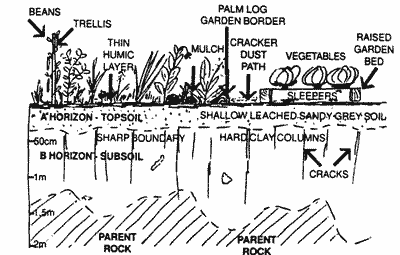
GARDEN PLANTS ARE GOING BUSH AND BECOMING ENVIRONMENTAL WEEDS
Weeds are plants that are growing in the wrong place.
While that oleander in your garden looks beautiful with its bright yellow flowers, it has the potential to contribute to a serious ecological problem - the problem of weed invasion into our native bushland. Many plants introduced for use in gardens have become pests. Three of Queensland's worst weeds - rubber vine, lantana and thunbergia - were deliberately introduced as garden ornamentals.
Environmental weeds are plants that are not native to an area, which spread quickly and invade native bushland and rural areas. It is up to us to make sure that introduced plants, some of which are attractive garden plants, don't escape from your garden to slowly and silently destroy our beautiful, unique bushland areas or degrade our agricultural lands.
Environmental weeds are vigorous invaders that smother native vegetation and take over to the exclusion of naturally occurring plants. Weeds are well suited to poor soil areas and are able to tough it out under a wide range of climatic conditions.
Even Australian native plants can be environmental weeds! When introduced into areas where they don't naturally occur, they can spread from your garden just as easily as the exotic weeds from other countries.
Introduced plants have few or no predators - enabling them to spread easily. They usually have highly successful mechanisms for reproduction. For example, one mature Chinee Apple (Indian jujube - Ziziphus mauritiana) can produce thousands of seeds annually.
Seeds of many weeds can remain dormant in the soil for years. Seeds can also be spread by birds, insects, wind and water. Other weeds can spread vegetatively when they are dumped in the local bush as garden waste. From these locations, corms, bulbs or stems lying on the ground, can shoot readily.
Environmental weeds spoil our native bushland by dramatically altering the environment.
Plants escape as seeds or cuttings in garden rubbish, growing over the fence or spread as seeds carried by birds or other animals. Weeds have no natural control agents, so they spread rapidly, smothering other vegetation and degrading agricultural land and native habitats. The most effective method of weed control is to recognise the weed and stop it before it starts to spread.
Townsville Soils
Townsville soils are generally poor in nutrient, humus, and trace elements. During the dry season, the soils are also low in moisture. Without your help, these factors limit the range of flora and fauna which can live productively through to the next wet season. The answer is to find ways of improving existing soils, rejuvenating degraded soils, and making them more productive.
How do we help?
Soil may seem like a fixed element in your garden, but soil can be changed for the better. The foundation of a successful edible landscape is an understanding of your soil. For example, Belgian Gardens used to be an area with market gardens, while other parts of Townsville have a history of flooding, saltwater inundation, and filled-in gullies, lagoons, mangrove swamps, and salt pans. The Parks and Services
Department of the Townsville City Council has put out an informative series of brochures describing the soil types in different areas of Townsville, with related plant selection guides. Suitable food plants are listed in the "Harvesting the Suburbs" brochure in this current series.
Soil Types
Townsville has a variety of soils, the predominant one being a sandy loam over clay soil. Typically, the topsoil is thin and poor in humus. This soil sets hard when dry, is highly erosive (forms bulldust), and becomes "boggy" when wet. The subsoil may be a hard grey alkaline (pH of 8+) columnar swelling clay with poor water permeability and storage capacity. These soils are a challenge to garden productivity in Townsville's urban and rural areas. They can be conditioned and improved in many ways:
• Deep ripping to allow water and root penetration.
• Adding sufficient amounts of gypsum makes clay permeable.
• Adding plenty of organic matter, particularly compost and mulch. This encourages the return of micro-flora and fauna. Ultimately, continual addition of organic matter will reduce the pH. For high pH, pine needles and well-rotted sawdust are ideal as mulch.
• For short term results, and to avoid the high pH, use raised garden beds or terracing with "imported" soil.
• Watering lightly, but long enough to ensure adequate penetration.
• Starting with plant species able to tolerate and "work" Townsville soils. Species include turmeric, five-in-one groundcover, south american custard apple, garlic, radish, sweetpea, canna, Syzygium wilsonii (flowers), curry leaf tree, many palms, pigeon pea, and sweet potato.
• Guarding against runoff by using barriers e.g. sleepers, logs, mulch, hay bales and fronds and by adding swales and contours.

Soil Fertility
Nutrients in the soil are used up by the plants you harvest, or are lost through leaching. You need to keep adding organic matter:
• mulch or green manures
• compost
• animal manures, and commercial organic
pellets.
The emphasis is on organic fertilizers because inappropriate use of chemical fertilizers can cause serious local and downstream environmental damage.
IN THE DRY TROPICS, REMEMBER: MULCH, MULCH, MULCH YOUR SOIL
TYPICAL TOWNSVILLE SOIL PROFILEDATE: November 1997
* * * * * * * * * * * * * * *
